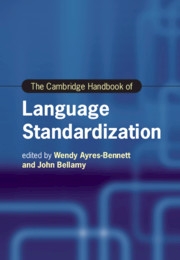Book contents
- The Cambridge Handbook of Language Standardization
- cambridge handbooks in language and linguistics
- The Cambridge Handbook of Language Standardization
- Copyright page
- Contents
- Figures
- Tables
- Contributors
- Introduction
- Part I Revisiting Models and Theories of Language Standardization
- Part II Legitimacy, Authority and the Written Form
- Part III Norms, Literacy and Education
- Part IV Beyond the National
- Part V Standardization in Late Modernity
- 25 Destandardization
- 26 Contemporary Perspectives on Language Standardization
- 27 Standardization and New Urban Vernaculars
- 28 Renegotiating Language Norms in Minority Contexts
- 29 Sign Language Standardization
- Name Index
- Subject Index
- References
27 - Standardization and New Urban Vernaculars
from Part V - Standardization in Late Modernity
Published online by Cambridge University Press: 01 July 2021
- The Cambridge Handbook of Language Standardization
- cambridge handbooks in language and linguistics
- The Cambridge Handbook of Language Standardization
- Copyright page
- Contents
- Figures
- Tables
- Contributors
- Introduction
- Part I Revisiting Models and Theories of Language Standardization
- Part II Legitimacy, Authority and the Written Form
- Part III Norms, Literacy and Education
- Part IV Beyond the National
- Part V Standardization in Late Modernity
- 25 Destandardization
- 26 Contemporary Perspectives on Language Standardization
- 27 Standardization and New Urban Vernaculars
- 28 Renegotiating Language Norms in Minority Contexts
- 29 Sign Language Standardization
- Name Index
- Subject Index
- References
Summary
This chapter reviews the existing literature on two types of linguistic phenomena, both related to dialect contact: on the one hand, the dynamics of language diffusion and convergence which lead to processes of ‘informal standardization’; and on the other, the mix of varieties that are found in urban centres following the demographic growth of the latter (usually due to immigration from other regions or countries). In the first part of this work, the study of these two phenomena is reviewed in the different historical phases of the literature on sociolinguistics and dialect contact, and a comparison is made between the two types of varieties which, according to most authors, result from each phenomenon, and which are respectively termed ‘unofficial spoken standards’ and ‘new urban vernaculars’ in this chapter. In the second part, the same issues are examined in detail in the literature on Arabic sociolinguistics. Here, the importance of examining the interaction between the processes connected to the two types of varieties is underlined, in light of the fact that the different strands of studies have focused on just one of these two aspects of Arabic dialect contact while neglecting the other.
Keywords
- Type
- Chapter
- Information
- The Cambridge Handbook of Language Standardization , pp. 713 - 740Publisher: Cambridge University PressPrint publication year: 2021
References
- 2
- Cited by



